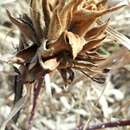pt-BR
nomes no trilho de navegação


Rabdophaga rosacea is a species of gall midge that creates rosette galls on roses found in the central plains of North America.[2][3][4]
The species was first described in 1908 by Ephraim Porter Felt from a collection made by Norman Criddle in Aweme, Manitoba, Canada.[1][5] The holotype, an adult male, is in the collection of the New York State Museum.[5]
The midge causes galls to form on the terminal buds of native roses (Rosa spp.) The galls are tightly packed leafy rosettes with a central cavity.[3][4][2]
The genus name 'Rabdophaga' is formed from two Greek roots; rhabdos- meaning a rod or staff[6] and -phaga meaning 'eater'[7] In older references the genus name is spelled 'Rhabdophaga'.[4] The specific name 'rosacea' refers to the genus of plants that are the hosts of the midge.[3][4][2]
As gall midges are one of the most diverse yet least known group of the true flies, a taxonomic revision of the world fauna of this group is in process.[8] In 2014, it was proposed that Rhadophaga rosacea be placed in Dasineura, a broadly defined polyphyletic genus of gall midges, as Dasineura rosacea.[5] Both Radophaga and Dasineura are within the tribe Dasineurini, a group of plant feeders that share several physical similarities.[5]
Rabdophaga rosacea is a species of gall midge that creates rosette galls on roses found in the central plains of North America.
The species was first described in 1908 by Ephraim Porter Felt from a collection made by Norman Criddle in Aweme, Manitoba, Canada. The holotype, an adult male, is in the collection of the New York State Museum.